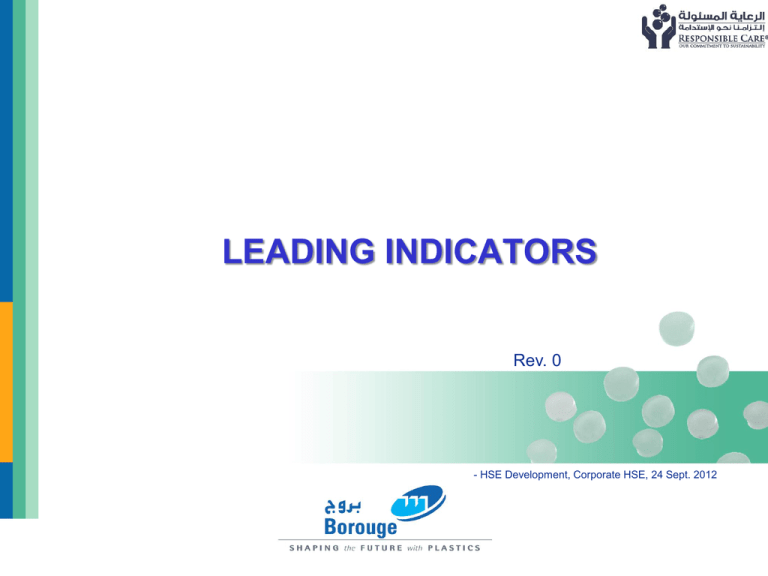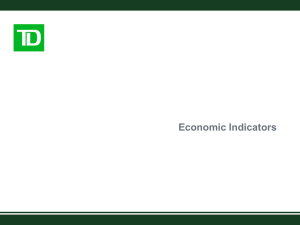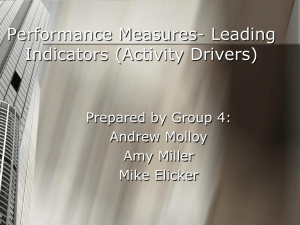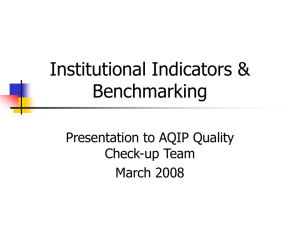sipchem_leading_indicators_rev0
advertisement

LEADING INDICATORS Rev. 0 - HSE Development, Corporate HSE, 24 Sept. 2012 1 Borouge reference line 2006 © 2006 Borouge CONTENTS • USE OF PERFORMANCE INDICATORS • LIMITATIONS OF LAGGING INDICATORS • DAILY LIFE EXAMPLES OF LEADING INDICATORS • BODY WEIGHT • DRIVING – DASHBOARD INFORMATION • BIRD’S TRIANGLE • LAGGING AND LEADING HSE INDICATORS • BEING REACTIVE OR PROACTIVE • RELATIONSHIP BETWEEN LEADING AND LAGGING INDICATORS • LEADING PERFORMANCE INDICATOR AS A PART OF PROCESS • METHODOLOGY FOR USING LEADING INDICATORS • BOROUGE STORY • CONCLUSION • BENCHMARKING 2 Borouge reference line 2006 © 2006 Borouge USE OF PERFORMANCE INDICATORS • Performance indicators provide information on: • What is happening around us; • How well we are doing; • What has happened so far (i.e. Historical Performances); • Warning of impending problems or dangers to enable us to take appropriate action. 3 Borouge reference line 2006 © 2006 Borouge LAGGING INDICATORS – LIMITATIONS (1) • Lagging indicators may not be sufficient because of • The time delay between the actions we take and the resulting outcome(s) i.e. information too late for us to respond. For example, by the time ill effects from smoking are apparent it may be too late to avoid ill health. 4 Borouge reference line 2006 © 2006 Borouge LAGGING INDICATORS – LIMITATIONS (2) • For plant operations where there is potential for disastrous outcomes but the likelihood of such events is extremely low, the absence of these events (lagging performance indicators) may not be a true indicator that the potential dangers are being proactively managed. The outcomes are so severe that one can’t wait for it to happen to find out that the implementation of the HSEMS has been effective or not. 5 Borouge reference line 2006 © 2006 Borouge LAGGING INDICATORS – LIMITATIONS (3) • Lagging indicators may fail to reveal latent hazards that have a significant potential to result in a disaster. The fact that a car’s engine is running doesn’t mean that it is not loosing oil and will not breakdown before the next service. Regular checking of the oil level is a sensible precaution and a leading indicator. 6 Borouge reference line 2006 © 2006 Borouge BODY WEIGHT • Comparing our weight to the healthy weight for somebody of our age and height can provide advance warning of potential future health problems such as Heart Disease. • Here body weight is the leading indicator. Advance warning of weight increase can encourage changes in diet and life style to reduce the risks. 7 Borouge reference line 2006 © 2006 Borouge DRIVING – DASHBOARD INFORMATION • Lagging Indicators: • • The odometer value provides the measure of how far we have travelled. Leading Indicators: • Petrol gauge, temperature gauge and oil indicator lamp provide information allowing us to take action before the car stops through lack of fuel or engine seizure. Lagging indicators provide information on the outcomes of our actions i.e. results from past actions. Leading indicators measure the inputs to the process that affect future outcomes. 8 Borouge reference line 2006 © 2006 Borouge BIRD’S TRIANGLE • Fatality In many cases HSE performance is reviewed by assessing lagging indicators. Lost Time • Lagging indicators like First Aid, Medical recordable, Lost time, Medical Recordable Fatality are outcomes. • First Aid Reactions to outcomes, though important, are like reacting to a stock market change rather than Near Miss incident occurred 9 Borouge reference line 2006 © 2006 Borouge predicting the change to protect investments. LAGGING AND LEADING HSE INDICATORS Fatality These are the outcomes we try to avoid Lost Time Lagging indicators Medical Recordable First Aid Near Miss – incident occurred Leader site visits; Leader Audits Leading indicators Permit to Work audits; JSA Audits; HSE Training Safety Critical Equipment PM; PM backlogs the Closure of actions - investigations; audits; HAZIDS Risk Safety Observations; Proactive Near-Miss reports 10 Borouge reference line 2006 © 2006 Borouge see Reading the signs of emerging risks BEING REACTIVE OR PROACTIVE Reactive feedback and control Input Desired Value Error Detect Process + Controller Output Accident & Incidents Frequency Lagging indicators monitor the outputs from the process. Corrective action is taken if the outputs deviate from the required standard. The control is reactive as corrective action cannot be initiated until the unwanted outputs have occurred. 11 Borouge reference line 2006 © 2006 Borouge Proactive feedback and control Input Process Leading Metrics Desired + Value Error Detect Controller Output Accident & Incidents Frequency Leading indicators monitor inputs to the process at stages before any adverse outcomes have occurred. Leading indicators provide feedback earlier in the process and enable proactive corrections to be made before any adverse outputs have resulted. RELATIONSHIP BETWEEN LEADING AND LAGGING INDICATORS • The effectiveness of leading performance indicators can be improved by better understanding the contributions that different inputs make to the desired output performance; • When using leading performance indicators, it is important to periodically analyze the relationships between the leading and lagging indicators that are being used and measure effectiveness. 12 Borouge reference line 2006 © 2006 Borouge LEADING PERFORMANCE INDICATOR AS A PART OF PROCESS • Monitoring the petrol level without responding when the gauge shows near empty or relying on a faulty gauge that always shows more than half full will not prevent the car stopping when it runs out of fuel. Leading performance indicators should be seen as a part of a process to guide actions that will improve future performance. 13 Borouge reference line 2006 © 2006 Borouge METHODOLOGY FOR USING LEADING INDICATORS • Identify where weakness or improvement; • Identify what can be done to counter a weakness or deliver on improvement opportunities; there are potential opportunities for • Set SMART performance standards for the actions identified; • Monitor performance standards; against Act Plan if the outcome deviates from the plan correct it The activity of improvement Check Do the • Take corrective actions to improve performance; • Repeat the process, using the continual improvement model. Measure the Outcomes Execute the plan Effective use of leading performance indicators can help to take the “luck” out of managing health, safety and environmental performance. 14 Borouge reference line 2006 © 2006 Borouge BOROUGE STORY – FROM LAGGING TO LEADING HSE INDICATORS INDICATOR TYPE Year 2010 KPI’s Year 2011 KPI’s % Serious Potential Incidents with RCA and Incident Investigation within 30 days of the incident occurrence. % Serious Potential Incident action close out within 30 days of target date LEADING Closeout of actions from process safety incidents (%) Year 2012 KPI’s % Serious Potential Incidents & TRI Investigation % of Serious Potential Incidents & TRI Investigation Action Close Out Occupational Health Improvement Program Milestones Emergency Exercises completed against plan Emergency Exercises (with OSC/IMT/CMT Involvement) Observation Tours Observation Tours HSE Training sessions completed against plan HSE Training (attendance) HSE CES assurance verification tasks completed within 30 days of plan HSE Critical Equipment Systems tested within 30 days of planned date Physical changes implemented following Management of Change process Management of Change – Physical changes implemented following MOC process TRI Frequency TRI Frequency TRI Frequency Quantity of Waste held at Ruwais Facility (Tons) Energy (MWh/Ton) Flaring (KT) Flaring KT of Hydrocarbon (YTD) Flaring KT of Hydrocarbon (YTD) LAGGING New / Development in year 2012 15 Borouge reference line 2006 © 2006 Borouge CONCLUSION • By measuring the input to a process, leading performance indicators can complement the use of lagging indicators and compensate for some of their short coming. • Leading indicators can monitor the effectiveness of the control systems and give advance warning of any developing weaknesses i.e. show the condition of systems before failure occurs. In this way, they help to control risks and prevent accidents. • Leading performance indicators can also measure the inputs that people are making to the management process. Used in this way they have a role in promoting and monitoring a positive culture towards improving HSE performance. • Leading performance indicators provide information that helps the user to respond to changing circumstances and take actions to achieve desired outcomes or avoid unwanted outcomes. • Leading Indicators should be objective and measurable; and provide information that guides action to improve performance. 16 Borouge reference line 2006 © 2006 Borouge BENCHMARKING • Leading performance indicators can be used for industry benchmarking; • This can be done using a set of leading performance indicators that are based on the actions that are considered to be of most importance for improving the performance of the Industry as a whole; • Performance standards can be developed based around the desired level of Industry Performance; • The benchmarking process can help to identify areas of weakness compared to other organizations and opportunities for improvement. These can provide a fruitful source of data that can be developed further for the organization’s own leading performance indicators. 17 Borouge reference line 2006 © 2006 Borouge Thank you for your time! 18 Borouge reference line 2006 © 2006 Borouge









